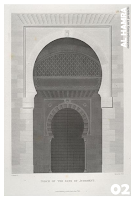James Cavanah Murphy spent the last 12 years of his life preparing notes and drawings for a publication on the Islamic al-Andalus architecture. The resulting book, The Arabian Antiquities of Spain*, was only partially published at his death in 1814. Thomas Hartwell Horne added text descriptions to Murphy’s measured drawings, and the whole was reprinted in 1815. Murphy’s careful documentation of the Great Mosque of Cordoba and the Alhambra in Granada are appreciative acknowledgements of the al-Andalus’ artistic achievements.
But who was James Cavanah Murphy?
James Cavanah Murphy (1760-1814) was an Irish architect, architectural draughtsman and author and is said to have been born of obscure parentage in Blackrock, Co. Cork, and to have trained as a bricklayer. A talent for drawing brought him to the attention of Sir James Chatterton, who provided the means for him to go to Dublin. In Dublin he became a pupil at the Dublin Society's drawing schools in about 1775. What he did during the next decade is not known. He is said to have been a member of the building committee for the extension of the Parliament House in 1786. On 9 November 1786, shortly before the death of the ailing Thomas Ivory, he was appointed master of the Society's School of Drawing in Architecture in Ivory's place, but the decision was reversed the following month, and in February 1787 Henry Aaron Baker, who had been acting head of the School for some time, was appointed instead.
Murphy benefited from the patronage and friendship of the Hon. William Burton Conyngham, who in 1788 sent him to Portugal to record the Dominican church and monastery of Batalha. Murphy arrived in Oporto in January 1789. His visit resulted in the publication of a folio volume of engraved plates, Plans, elevations, sections and views of the church of Batalha…To which is prefixed and introductory discourse on the principles of Gothic architecture (London, 1795), as well as Travels in Portugal (1795) and A General View of the State of Portugal (1798). According to Croker, he also 'acquired a profound knowledge of the Portuguese and Spanish languages, and held for a short time a diplomatic situation of importance'. Murphy was back in Dublin by 1790 but was travelling in England in October of the same year. Little is known about his activities during the period 1791 to 1802; a view by him of the lavabo at Mellifont Abbey, from the collection of William Burton Conyngham was published in Grose's Antiquities of Ireland (1791). He may possibly be the Murphy who was one of eight architects to submit designs in the competition for St George's church, Dublin, in 1800.
In 1802 Murphy returned to the Iberian Peninsula, this time to Cadiz, where he remained for seven years studying al-Andalus architecture. He returned to England in 1809 and settled in London. After his return he worked on an invention for the prevention of dry-rot in timber. He died, unmarried, on 12 September 1814 at Edward Street, Cavendish Square and was buried in Carrigrohan graveyard, Co. Cork. His ‘Arabian Antiquities of Spain’ and ‘A History of the Mohametan Empire in Spain’ were published posthumously in 1816. A drawing by him was exhibited at the First Munster Exhibition, Cork, in 1815 and several more at the Cork Society for Promoting the Fine Arts in 1816, 1819 and 1820.
Following his death many of Murphy's notes and drawings were acquired by Thomas Deane; a bound album of 'Sketches taken in Portugal in 1789 & 1790' from this source is now in the National Library of Ireland, which also has a design by him for a monument to Henry Fielding in the graveyard of the Anglican church in Lisbon. A drawing by Murphy of the principal front of Slane Castle, showing the building as completed in 1787, is in the IAA, Murray Collection. Other drawings by Murphy are in the library of the University of Athens (in the process of being catalogued by the late Professor Michael McCarthy) and in the Society of Antiquaries (London).
(Click the images to enlarge)
(Click the images to enlarge)
01 Elevation of the ancient gate of Judgment
02 Porch of the gate of Judgment
03 Elevation of the Puerta del Vino (Wine-Gate)
04 Elevation of a small portico near the chapel
05 Elevation of the portico on the North side of the Patio del Agua (Court of the Water)
06 Elevation of an alcove in the Patio del Agua (Court of the Water)
07 A section of the baths in the Alhambra
08 Concert room of the baths
09 A section of the hall of the baths
10 Elevation of the portico of the Generalife
11 Front view of the portico of the Generalife
* The scant biographical notices of James Cavanah Murphy show that he went to Spain in 1802 and was engaged in unspecified diplomatic missions for the court of Portugal to the Spanish court during the next seven years. His principal occupation, however, was in architectural draughtsmanship and the fame of his folio on Batalha led the Governor of the Alhambra to give him carte blanche to draw every detail of that world-famous monument as the Governor was 'desirous that the knowledge of its splendid architectural remains should be accurately transmitted to posterity.' He was indulged similarly by the Governor of Cordoba and these two sites are the principal subject of The Arabian Antiquities of Spain. He returned to London in 1809 to prepare it for publication, which finally happened in 1815. James Cavanah Murphy - did not live to see its publication. He died on 12 September 1814, 'a victim of his labours', the accounts tell us.












No comments:
Post a Comment